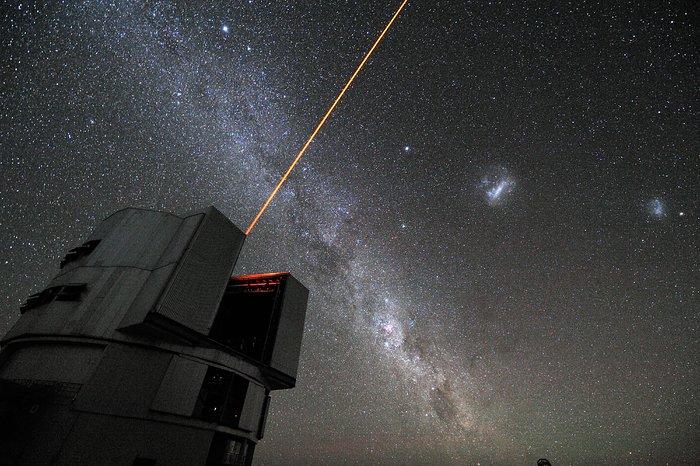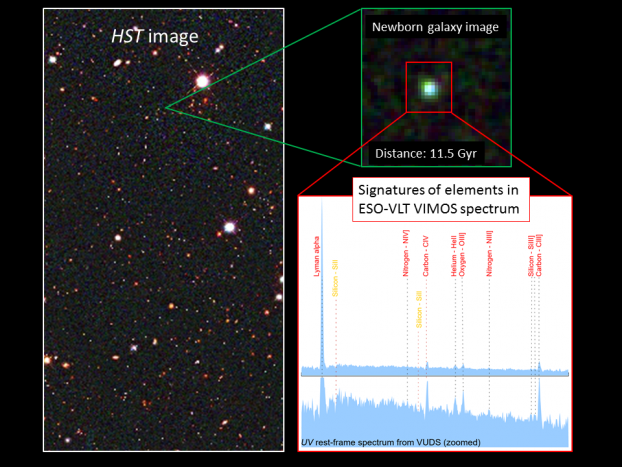A detailed look at emerging galaxies
By pushing the largest telescopes to their limits, an international team of astronomers involving French researchers from the Laboratoire d’Astrophysique de Marseille (CNRS / Aix-Marseille University) and the Institut de Recherche en Astrophysique et Planétologie of Toulouse (CNRS / University of Toulouse Paul Sabatier) has discovered a population of small nascent galaxies at a distance of more than 11 billion light years, which gives us valuable information about the early stages of galaxy formation. Although rare, these galaxies reveal with unprecedented detail the extreme physical conditions that existed when the first galaxies formed just after the Big Bang. The article was published in Nature Astronomy on March 2, 2017.

The birth and early evolution of galaxies – such as our Milky Way – in the few hundred million years after the Big Bang is still largely inaccessible to today’s means of observation. In recent decades, galaxies have been observed up to the so-called “Dark Ages”, in the first 700 million years, when the universe was filled with a dense hydrogen cloud. These early galaxies are very faint and buried in a gas mist. It is therefore very difficult to observe them from today’s observatories, and their birth and early stages of assembly have never been observed in detail.
To identify and study the properties of newly formed galaxies, an international team followed a different approach presented in a new study published in the March issue of the journal Nature Astronomy. In fact, new galaxies continue to form long after the “Dark Ages”, and this new study identified nascent galaxies observed later in the life of the universe, about a billion years after the “Dark Ages”, when the universe was only 5% of its current age. Being nevertheless a little closer to us and out of the fog in which they were previously bathed, these galaxies are easier to study in detail, which allowed this team to observe all the properties of galaxies in their early moments.
This discovery required a major observational effort, coordinated in the VIMOS Ultra-Deep Survey (VUDS), the largest survey of galaxies at these distances conducted with the Very Large Telescope (VLT) of the European Southern Observatory in Chile. It is in particular thanks to the very sensitive spectroscopy obtained with the VIMOS spectrograph at the VLT, complemented by images from the Hubble Space Telescope (NASA-ESA), that the team was able to study the properties of these “child galaxies” in unprecedented detail.
“For the first time we can observe a population of extremely young galaxies with all the properties expected of the first galaxies much earlier in the universe. We can observe them in unparalleled detail,” says Ricardo Amorin of the Rome Astronomical Observatory (INAF), now working at the University of Cambridge (UK).
The spectra obtained with VIMOS show that these galaxies are very rich in ionized gas, “with very little dust and so-called metallic elements, such as Carbon and Oxygen, which are produced by the first massive stars in a galaxy and dispersed very early when these stars die,” says Enrique Perez-Montero of the Institute of Astrophysics of Andalusia, co-author of the article. These very hot stars illuminate (ionize) the surrounding gas before dying as supernovae in a gigantic explosion producing large-scale gas flows that carry away the gas and metallic elements. The authors propose that this mechanism could explain how their early analogues polluted the universe with these metallic elements and cleaned their environment of gas, contributing to the end of the “Dark Ages”.

Adriano Fontana of the Rome Observatory (INAF), and co-author of the study, explains: “We are observing these galaxies during what seems to be their first episode of massive star formation, which makes them very luminous”. Olivier Le Fèvre, from the Laboratoire d’Astrophysique de Marseille (Aix-Marseille University and CNRS) and scientific manager of the VUDS program, adds: “We were able to find these galaxies thanks to very deep observations of an unprecedented sample of more than two thousand galaxies. Images from the Hubble Space Telescope show galaxies that are about 30 times smaller and 100 times less massive than our Milky Way, with compact and irregular shapes sometimes appearing as pairs of coalescing galaxies”.
The galaxies discovered in this study shed new light on the still largely unknown process of the formation of the first galaxies. The methods implemented prepare for a better interpretation of the data that will be obtained with the future James Webb Space Telescope (JWST, NASA-ESA-CSA) to be launched from Kourou at the end of 2018. An exciting and potentially revolutionary era in observational cosmology and the study of galaxy formation has just begun.
Further Resources
- Scientific publication : Analogues of primeval galaxies two billion years after the Big Bang, Nature Astronomy 1, Article number: 0052 (2017), 2 mars 2017
- Commentaire “News and views” dans Nature Astronomy, par le prof. Alice Shapley (Department of Physics and Astronomy, University of California Los Angeles, USA)
- Article de l’INAF
- Communiqué de Presse du CNRS-INSU
IRAP Contact
- Thierry Contini, thierry.contini@irap.omp.eu






